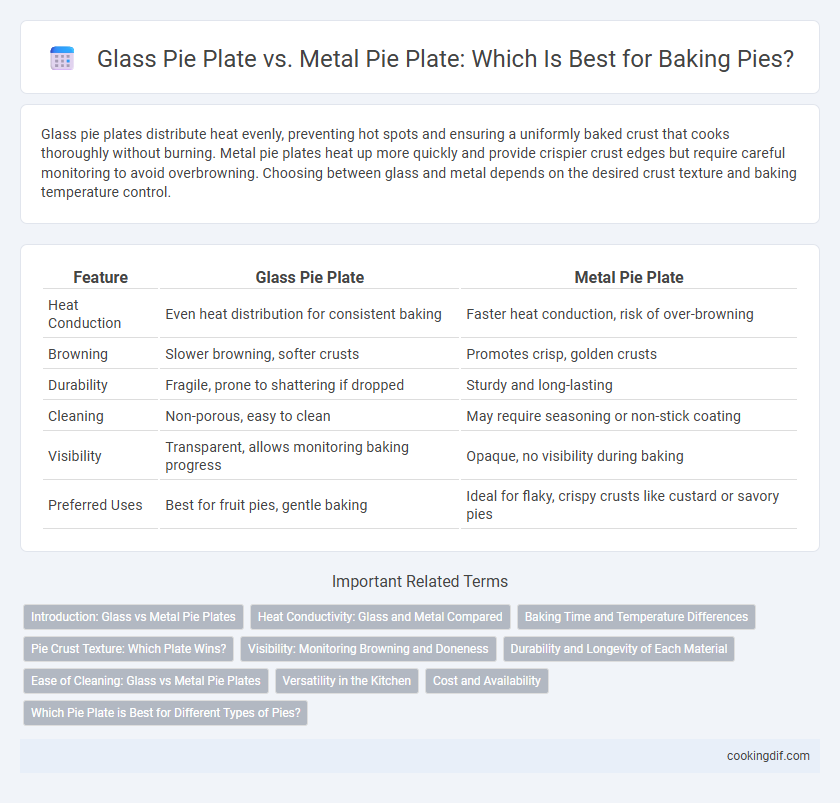Glass pie plates distribute heat evenly, preventing hot spots and ensuring a uniformly baked crust that cooks thoroughly without burning. Metal pie plates heat up more quickly and provide crispier crust edges but require careful monitoring to avoid overbrowning. Choosing between glass and metal depends on the desired crust texture and baking temperature control.
Table of Comparison
| Feature | Glass Pie Plate | Metal Pie Plate |
|---|---|---|
| Heat Conduction | Even heat distribution for consistent baking | Faster heat conduction, risk of over-browning |
| Browning | Slower browning, softer crusts | Promotes crisp, golden crusts |
| Durability | Fragile, prone to shattering if dropped | Sturdy and long-lasting |
| Cleaning | Non-porous, easy to clean | May require seasoning or non-stick coating |
| Visibility | Transparent, allows monitoring baking progress | Opaque, no visibility during baking |
| Preferred Uses | Best for fruit pies, gentle baking | Ideal for flaky, crispy crusts like custard or savory pies |
Introduction: Glass vs Metal Pie Plates
Glass pie plates conduct heat evenly, promoting uniform baking and reducing the risk of burnt crusts, making them ideal for delicate pies with light crusts. Metal pie plates, especially aluminum, heat up quickly, resulting in crispier, golden-brown edges, favored for fruit pies and recipes requiring a firmer crust. The choice between glass and metal pie plates depends on the desired crust texture and baking consistency.
Heat Conductivity: Glass and Metal Compared
Metal pie plates offer superior heat conductivity, allowing for faster and more even heat distribution that promotes a crisp, golden crust. Glass pie plates heat more slowly and retain heat longer, which can result in a more evenly baked filling but may require adjustments in baking time. Choosing between glass and metal depends on the desired crust texture and baking precision, with metal preferred for quick browning and glass favored for thorough cooking of fillings.
Baking Time and Temperature Differences
Glass pie plates typically require a 25degF lower baking temperature and slightly longer baking time compared to metal pie plates due to their heat-retaining properties. Metal pie plates heat up quickly and promote faster browning, allowing pies to bake more evenly within a shorter time frame. Adjusting baking time and temperature when switching between glass and metal ensures optimal crust texture and preventing undercooked or overbaked fillings.
Pie Crust Texture: Which Plate Wins?
Glass pie plates provide even heat distribution that helps achieve a golden, crisp pie crust with less risk of burning, while metal pie plates heat up quickly, promoting a flakier and browner crust. The smooth, non-reactive surface of glass ensures consistent baking without imparting metallic taste, ideal for delicate fruit pies. Metal plates conduct heat faster, resulting in a crust with a slightly crunchier texture, favored for savory or custard pies.
Visibility: Monitoring Browning and Doneness
Glass pie plates offer superior visibility during baking, allowing easy monitoring of browning and doneness from the sides and bottom, which is especially helpful for fruit pies and custard-based recipes. Metal pie plates, typically opaque and dark-colored, conduct heat more efficiently but obscure the crust's progressing color, requiring visual checks from above and estimated timing based on experience. Choosing glass enhances precise control over crust texture and prevents overbaking through real-time observation, while metal ensures quicker heat conduction and crispier crusts.
Durability and Longevity of Each Material
Glass pie plates offer excellent heat retention and distribute heat evenly, reducing the risk of uneven baking, while being less prone to warping or rusting over time. Metal pie plates, especially those made from aluminum or stainless steel, provide superior durability and resistance to impact, but may be more susceptible to scratches, dents, and corrosion if not properly maintained. For long-term use, metal plates generally last longer due to their robust construction, whereas glass plates require careful handling to avoid chipping or cracking.
Ease of Cleaning: Glass vs Metal Pie Plates
Glass pie plates offer a non-porous surface that resists staining and makes removing baked-on residue easier compared to metal pie plates. Metal pie plates, especially those without non-stick coatings, tend to hold onto grease and food particles, requiring more rigorous scrubbing. Choosing glass over metal enhances ease of cleaning and reduces the risk of retaining odors or discoloration after multiple uses.
Versatility in the Kitchen
Glass pie plates provide even heat distribution, ensuring consistent baking results and are ideal for monitoring crust browning through their transparent design. Metal pie plates heat up quickly and are preferred for achieving a flaky, crisp crust due to their conductive properties. Both options offer versatile benefits in the kitchen, with glass excelling in slow, even cooking and metal excelling in faster, high-heat scenarios.
Cost and Availability
Glass pie plates generally cost more than metal pie plates due to their material and manufacturing process, but they are widely available in most kitchenware stores and online retailers. Metal pie plates are typically more affordable and come in various options such as aluminum, stainless steel, and nonstick coatings, making them a budget-friendly choice for many bakers. Both types are readily accessible, yet metal pie plates often offer greater variety in price points and styles, catering to different consumer needs.
Which Pie Plate is Best for Different Types of Pies?
Glass pie plates distribute heat evenly, making them ideal for fruit pies that require thorough, consistent baking to achieve a crisp crust and juicy filling. Metal pie plates heat up quickly and retain high temperatures, perfect for custard and cream pies that benefit from rapid baking and browned edges. Choosing between glass and metal pie plates depends on pie type: glass excels with slow, even cooking for fruit pies, while metal suits pies needing fast, intense heat.
Glass pie plate vs Metal pie plate for baking pies Infographic

 cookingdif.com
cookingdif.com